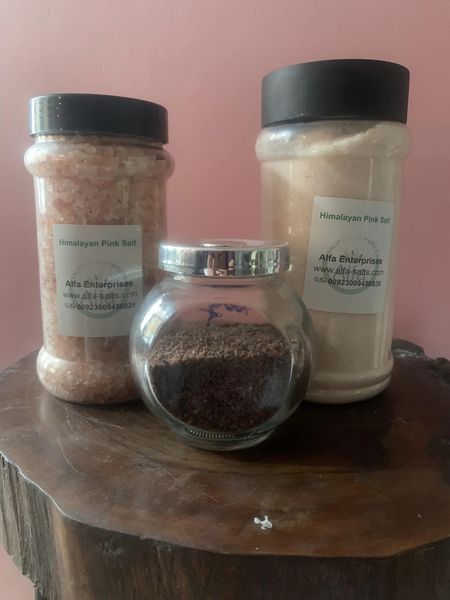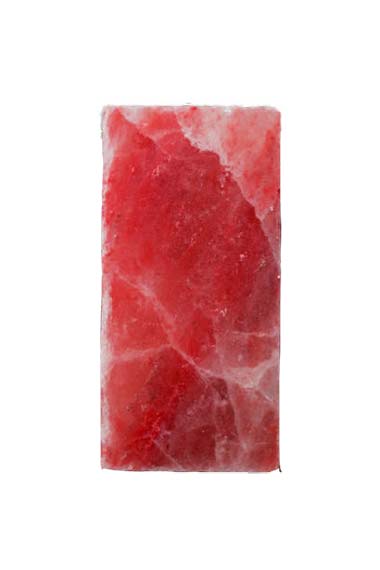Himalayan pink/black salt (fine and Coarse) is a type of rock salt mined from the Salt Range Mountains in the Punjab region of Pakistan. It comes in various forms, including pink, white, and black varieties. The pink color of Himalayan salt is due to its mineral content, particularly iron oxide. The black color, on the other hand, is often attributed to activated charcoal, which is sometimes added to create a distinct look.
Both fine and coarse versions of Himalayan pink or black salt are available:
- Fine Himalayan salt: This type of salt is finely ground, similar to table salt but with a pink or black hue. It’s commonly used in cooking, seasoning, and as a finishing salt to sprinkle over dishes just before serving. Fine Himalayan salt dissolves quickly and can be easily measured and incorporated into recipes.
- Coarse Himalayan salt: Coarse Himalayan salt consists of larger crystals or granules. It’s often used in salt grinders or mills to be ground fresh when needed. Coarse salt is ideal for seasoning meats, vegetables, or for creating a salt crust on dishes like whole fish or roasted meats. It’s also used in brines for preserving or flavoring food.
Himalayan salt is believed by some to have health benefits due to its mineral content, though scientific evidence supporting these claims is limited. It contains trace amounts of minerals like calcium, potassium, magnesium, and iron, which give it its distinctive color and taste.
It’s important to note that while Himalayan salt is considered a more natural and less processed alternative to table salt, it should still be consumed in moderation like any other salt due to its sodium content.
Himalayan pink and black salt are believed by some to offer certain health benefits, although scientific evidence supporting these claims is limited. Here are some purported health benefits associated with these salts:
- Rich in Minerals: Himalayan salt contains trace minerals such as calcium, potassium, magnesium, and iron. Proponents claim that these minerals are beneficial for maintaining proper electrolyte balance, supporting bone health, and aiding muscle function.
- Lower Sodium Content: Some individuals believe that Himalayan salt contains slightly lower amounts of sodium compared to regular table salt. However, this difference is minimal, and both types of salt should be consumed in moderation due to their sodium content.
- Alkalizing Properties: Advocates suggest that Himalayan salt may help balance the body’s pH levels, promoting a more alkaline environment. However, the impact of dietary changes on the body’s pH is a complex topic and not solely dependent on salt intake.
- Hydration and Electrolyte Balance: The trace minerals present in Himalayan salt are thought to support hydration and maintain proper electrolyte balance in the body.
- Asthma and Respiratory Health: Some traditional practices involve using Himalayan salt inhalers or salt therapy rooms for respiratory conditions like asthma and allergies. However, scientific evidence supporting its efficacy is limited.
It’s important to note that while these potential health benefits are often touted, scientific studies have not consistently supported these claims. Also, any potential health benefits of Himalayan salt are likely to be outweighed by the negative effects of excessive salt consumption, such as increased blood pressure and cardiovascular issues.
As with any dietary changes or health-related decisions, it’s advisable to consult with a healthcare professional for personalized advice, especially if you have specific health conditions or concerns.
Himalayan pink and black salts, whether fine or coarse, undergo different processes in terms of size and manufacturing:
Size:
- Fine Himalayan Salt: This type is finely ground to create smaller granules similar in size to table salt. It is ideal for use in cooking, seasoning, and as a finishing salt due to its smaller particle size, which allows for quicker dissolution and easier incorporation into dishes.
- Coarse Himalayan Salt: Coarse salt consists of larger crystals or granules. These larger particles are well-suited for use in salt grinders or mills. Coarse salt is often used for seasoning meats, vegetables, creating salt crusts on dishes, or for decorative purposes in presentations.
Manufacturing:
- Mining: Himalayan salt is harvested from mines located in the Salt Range mountains of Pakistan. The salt is extracted manually, primarily through mining techniques that involve breaking down large salt rocks into smaller pieces.
- Processing: Once extracted, the salt undergoes various processes depending on the desired end product. For fine salt, it is ground into smaller particles through grinding or milling processes. For coarse salt, the larger crystals or chunks may be sorted and packaged directly or further broken down into desired sizes.
For the black variation of Himalayan salt, the addition of activated charcoal or other additives contributes to its distinct color. The manufacturing process for black Himalayan salt is generally similar to that of pink Himalayan salt, with the addition of activated charcoal for coloring purposes.
Manufacturers often package Himalayan salts in different sizes and forms, catering to various culinary and decorative purposes. These salts are commonly available in different-sized crystals or ground into fine powders for different applications in cooking, seasoning, or presentation.
When purchasing Himalayan salt, whether pink or black, consumers may find it labeled as fine or coarse, depending on the intended use and particle size required for their culinary needs.
Looking for edible salt: Click here





